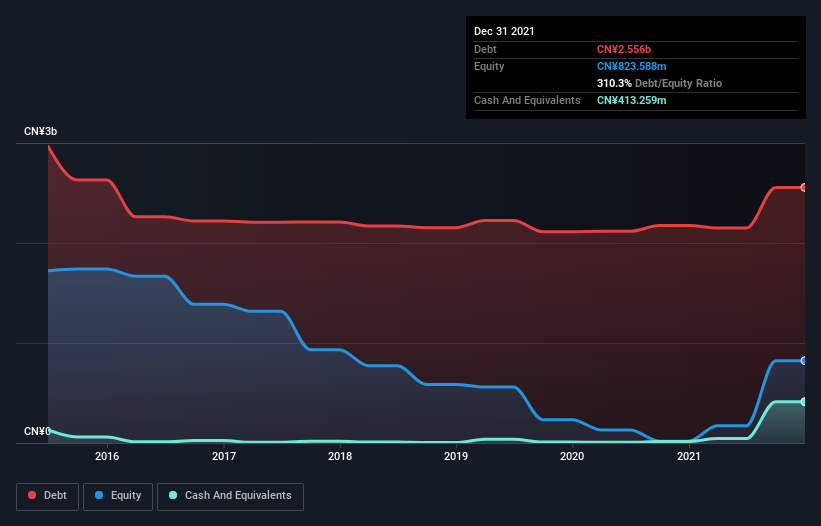Legendary fund manager Li Lu (who Charlie Munger backed) once said, 'The biggest investment risk is not the volatility of prices, but whether you will suffer a permanent loss of capital.' When we think about how risky a company is, we always like to look at its use of debt, since debt overload can lead to ruin. We can see that Ko Yo Chemical (Group) Limited (HKG:827) does use debt in its business. But is this debt a concern to shareholders?
Why Does Debt Bring Risk?
Debt is a tool to help businesses grow, but if a business is incapable of paying off its lenders, then it exists at their mercy. Ultimately, if the company can't fulfill its legal obligations to repay debt, shareholders could walk away with nothing. While that is not too common, we often do see indebted companies permanently diluting shareholders because lenders force them to raise capital at a distressed price. Of course, debt can be an important tool in businesses, particularly capital heavy businesses. When we examine debt levels, we first consider both cash and debt levels, together.
See our latest analysis for Ko Yo Chemical (Group)
What Is Ko Yo Chemical (Group)'s Net Debt?
As you can see below, at the end of December 2021, Ko Yo Chemical (Group) had CN¥2.56b of debt, up from CN¥2.17b a year ago. Click the image for more detail. However, it does have CN¥413.3m in cash offsetting this, leading to net debt of about CN¥2.14b.

How Healthy Is Ko Yo Chemical (Group)'s Balance Sheet?
According to the last reported balance sheet, Ko Yo Chemical (Group) had liabilities of CN¥2.36b due within 12 months, and liabilities of CN¥853.7m due beyond 12 months. Offsetting these obligations, it had cash of CN¥413.3m as well as receivables valued at CN¥531.0m due within 12 months. So its liabilities total CN¥2.27b more than the combination of its cash and short-term receivables.
This deficit casts a shadow over the CN¥1.35b company, like a colossus towering over mere mortals. So we'd watch its balance sheet closely, without a doubt. At the end of the day, Ko Yo Chemical (Group) would probably need a major re-capitalization if its creditors were to demand repayment.
We measure a company's debt load relative to its earnings power by looking at its net debt divided by its earnings before interest, tax, depreciation, and amortization (EBITDA) and by calculating how easily its earnings before interest and tax (EBIT) cover its interest expense (interest cover). Thus we consider debt relative to earnings both with and without depreciation and amortization expenses.
Ko Yo Chemical (Group)'s debt is 3.0 times its EBITDA, and its EBIT cover its interest expense 3.2 times over. Taken together this implies that, while we wouldn't want to see debt levels rise, we think it can handle its current leverage. One redeeming factor for Ko Yo Chemical (Group) is that it turned last year's EBIT loss into a gain of CN¥503m, over the last twelve months. When analysing debt levels, the balance sheet is the obvious place to start. But it is Ko Yo Chemical (Group)'s earnings that will influence how the balance sheet holds up in the future. So if you're keen to discover more about its earnings, it might be worth checking out this graph of its long term earnings trend.
Finally, a company can only pay off debt with cold hard cash, not accounting profits. So it's worth checking how much of the earnings before interest and tax (EBIT) is backed by free cash flow. Over the last year, Ko Yo Chemical (Group) recorded negative free cash flow, in total. Debt is usually more expensive, and almost always more risky in the hands of a company with negative free cash flow. Shareholders ought to hope for an improvement.
Our View
Mulling over Ko Yo Chemical (Group)'s attempt at staying on top of its total liabilities, we're certainly not enthusiastic. Having said that, its ability to grow its EBIT isn't such a worry. Taking into account all the aforementioned factors, it looks like Ko Yo Chemical (Group) has too much debt. That sort of riskiness is ok for some, but it certainly doesn't float our boat. The balance sheet is clearly the area to focus on when you are analysing debt. But ultimately, every company can contain risks that exist outside of the balance sheet. Case in point: We've spotted 4 warning signs for Ko Yo Chemical (Group) you should be aware of, and 1 of them is concerning.
At the end of the day, it's often better to focus on companies that are free from net debt. You can access our special list of such companies (all with a track record of profit growth). It's free.
Valuation is complex, but we're here to simplify it.
Discover if Ko Yo Chemical (Group) might be undervalued or overvalued with our detailed analysis, featuring fair value estimates, potential risks, dividends, insider trades, and its financial condition.
Access Free AnalysisHave feedback on this article? Concerned about the content? Get in touch with us directly. Alternatively, email editorial-team (at) simplywallst.com.
This article by Simply Wall St is general in nature. We provide commentary based on historical data and analyst forecasts only using an unbiased methodology and our articles are not intended to be financial advice. It does not constitute a recommendation to buy or sell any stock, and does not take account of your objectives, or your financial situation. We aim to bring you long-term focused analysis driven by fundamental data. Note that our analysis may not factor in the latest price-sensitive company announcements or qualitative material. Simply Wall St has no position in any stocks mentioned.
About SEHK:827
Ko Yo Chemical (Group)
An investment holding company, engages in the research and development, manufacture, marketing, and distribution of chemical products and chemical fertilizers in the People’s Republic of China.
Slight risk and slightly overvalued.
Market Insights
Community Narratives



